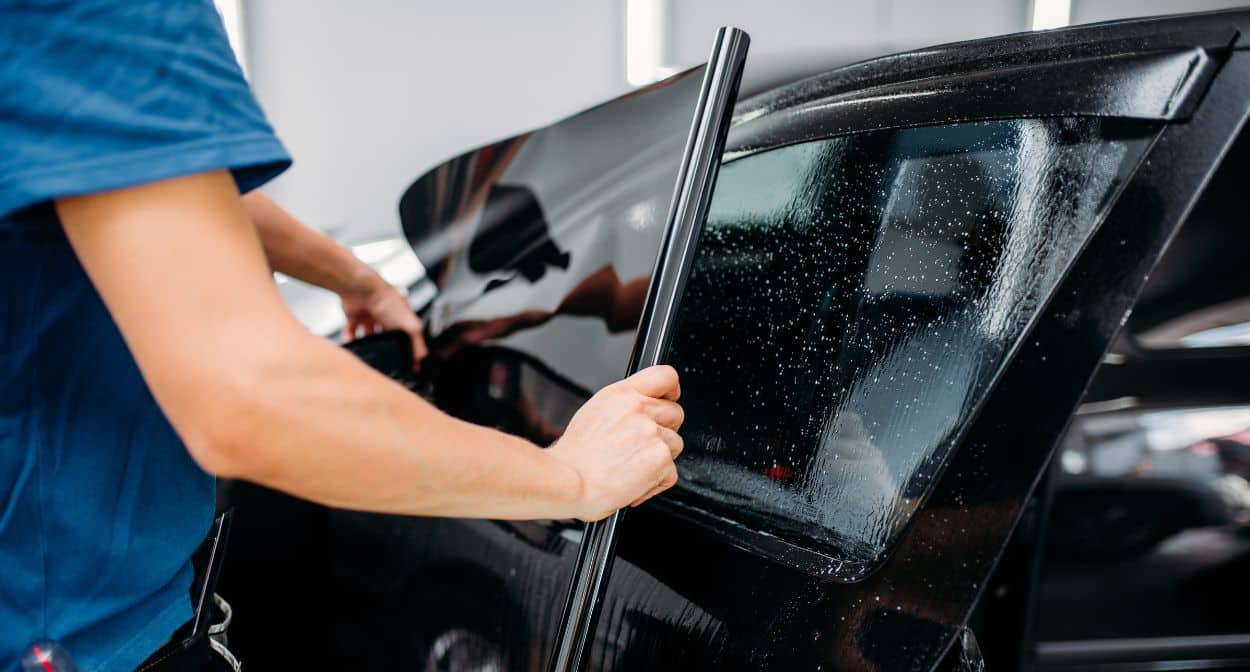Understanding Window Tinting Films

- Ceramic Window Tinting Film: Known for its high performance and durability, ceramic tint is a non-metallic film that utilizes advanced ceramic nanoparticles to block UV rays, reduce glare, and regulate heat.
- Metallic Window Tinting Film: This type contains tiny metallic particles that create a reflective finish and are effective in blocking heat and glare, though they can interfere with signals due to their metal content.
Heat Rejection and UV Protection
One of the primary reasons for tinting windows is to reduce heat and UV exposure inside a vehicle or building. Both ceramic and metallic films perform well, but there are some notable differences.
- Ceramic Tinting Film: Ceramic films are excellent at blocking infrared light, the primary source of heat, often blocking up to 85% of heat-producing rays. Additionally, ceramic tint can block up to 99% of harmful UV rays, helping to protect your skin and interior furnishings from sun damage and fading.
- Metallic Tinting Film: Metallic tints are also highly effective at reducing heat and UV rays, though generally slightly less so than ceramic films. These films can block up to 70-80% of heat-producing rays and about 99% of UV rays. However, metallic tints also create a reflective effect that can contribute to heat rejection by bouncing light away.
Winner: Ceramic tinting film generally offers superior heat rejection without the reflectivity of metallic films, making it the better choice for those focused on maximum heat and UV protection.
Signal Interference

The materials in window tinting films can impact their ability to interact with certain signals, which may be important if you rely on electronic devices.
- Ceramic Tinting Film: One of the key benefits of ceramic tint is that it doesn’t contain any metallic particles, meaning it won’t interfere with signals from cell phones, GPS, or other electronic devices. This makes ceramic tint an ideal choice for anyone who needs uninterrupted connectivity.
- Metallic Tinting Film: Due to the metallic particles in the film, metallic tints are prone to signal interference. This can affect cell phone reception, GPS, and other signals, which may be inconvenient for those who rely heavily on these technologies.
Winner: Ceramic tint is the clear choice for those who prioritize uninterrupted device connectivity.
Appearance and Aesthetic Appeal
Window tints can add a sleek, modern look to a vehicle or building, but the appearance of ceramic and metallic films can vary significantly.
- Ceramic Tinting Film: Ceramic tints provide a darker, more matte finish, which can create a subtle and elegant look without the reflective glare associated with metallic tints. This makes ceramic tints a popular choice for those who prefer a non-reflective, sophisticated appearance.
- Metallic Tinting Film: Metallic tints create a shiny, reflective finish that is often more noticeable. While this can add a bold look to vehicles, it may not be the ideal aesthetic for everyone. Additionally, the reflective finish can sometimes be distracting, particularly for vehicles.
Winner: Ceramic tint is usually preferred for those who want a sleek, understated look, while metallic tint is more suited to those who like a reflective finish.
Clarity and Glare Reduction

- Ceramic Tinting Film: Ceramic tint provides excellent clarity and reduces glare without significantly altering the color or visibility of the windows. This makes it ideal for drivers who want to minimize glare but maintain clarity.
- Metallic Tinting Film: While metallic films also offer good glare reduction, the reflective finish can sometimes cause distractions or create glare for other drivers on the road.
Winner: Ceramic tinting film is generally preferred for optimal clarity and glare reduction.
Durability and Longevity
Durability is another factor to consider when choosing a window tint, as high-quality tints can last for many years without fading or peeling.
- Ceramic Tinting Film: Ceramic films are highly durable and are less likely to fade or peel over time. They’re also scratch-resistant, making them a long-lasting choice.
- Metallic Tinting Film: Metallic tints are also durable, but they may fade over time and, in some cases, can be prone to scratching. The metallic finish may gradually wear, impacting its appearance.
Winner: Ceramic tinting film generally has a longer lifespan and greater durability, making it a better long-term investment.
Cost Considerations

The cost of window tinting varies widely based on the material and installation process.
- Ceramic Tinting Film: Ceramic tint is typically more expensive than metallic tint due to its advanced materials and superior performance. However, the benefits it provides often justify the investment for those looking for premium quality.
- Metallic Tinting Film: Metallic tinting is more affordable than ceramic tint, making it a more budget-friendly option. It still offers decent protection and heat rejection, though it may lack some of the performance and longevity of ceramic film.
Winner: For those on a budget, metallic tint is a good choice, while ceramic tint offers more value for those willing to invest in long-term quality.
Final Decision: Which Is Right for You?
Choosing between ceramic and metallic tinting films ultimately depends on your priorities. If you’re seeking the highest quality, maximum heat rejection, and no signal interference, ceramic tinting film is the ideal choice, especially for those who want a sleek, matte finish with long-lasting durability. However, if you’re looking for an affordable option that still offers good heat rejection and don’t mind some signal interference, metallic tinting film is a solid choice.
In summary:
- Ceramic Tinting Film: Best for those who want premium quality, high heat rejection, no signal interference, and a sleek, matte finish.
- Metallic Tinting Film: Suitable for those on a budget who value heat rejection and are okay with a reflective look and potential signal interference.
Choosing the right tinting film can enhance comfort, reduce energy costs, and improve the appearance of your vehicle or building. Consider your specific needs to make an informed decision that provides the right balance of style, functionality, and budget.



